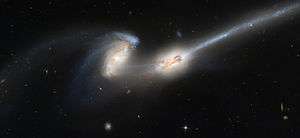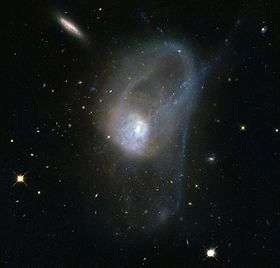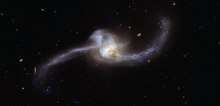Galaxy merger

Galaxy mergers can occur when two (or more) galaxies collide. They are the most violent type of galaxy interaction. The gravitational interactions between galaxies and the friction between the gas and dust have major effects on the galaxies involved. The exact effects of such mergers depend on a wide variety of parameters such as collision angles, speeds, and relative size/composition, and are currently an extremely active area of research. Galaxy mergers are important because the merger rate is fundamental measurement of galaxy evolution. The merger rate also provides astronomers with clues about how galaxies bulked up over time.[1]
Description
During the merger, stars and dark matter in each galaxy become affected by the approaching galaxy. Toward the late stages of the merger, the gravitational potential (i.e. the shape of the galaxy) begins changing so quickly that star orbits are greatly affected, and lose any memory of their previous orbit. This process is called violent relaxation.[3] Thus if two disk galaxies collide, they begin with their stars in an orderly rotation in the plane of the disk. During the merger, the ordered motion is transformed into random energy. The resultant galaxy is dominated by stars that orbit the galaxy in a complex, and random, web of orbits. This is what we see in elliptical galaxies, stars on random unordered orbits.
Mergers are also locations of extreme amounts of star formation.[5] The star formation rate (SFR) during a major merger can reach thousands of solar masses worth of new stars each year, depending on the gas content of each galaxy and its redshift.[6][7] Typical merger SFRs are less than 100 new solar masses per year.[8][9] This is large compared to our Galaxy, which makes only a few (~2) new stars each year.[10] Though stars almost never get close enough to actually collide in galaxy mergers, giant molecular clouds rapidly fall to the center of the galaxy where they collide with other molecular clouds. These collisions then induce condensations of these clouds into new stars. We can see this phenomenon in merging galaxies in the nearby universe. Yet, this process was more pronounced during the mergers that formed most elliptical galaxies we see today, which likely occurred 1-10 billion years ago, when there was much more gas (and thus more molecular clouds) in galaxies. Also, away from the center of the galaxy gas clouds will run into each other producing shocks which stimulate the formation of new stars in gas clouds. The result of all this violence is that galaxies tend to have little gas available to form new stars after they merge. Thus if a galaxy is involved in a major merger, and then a few billion years pass, the galaxy will have very few young stars (see Stellar evolution) left. This is what we see in today's elliptical galaxies, very little molecular gas and very few young stars. It is thought that this is because elliptical galaxies are the end products of major mergers which use up the majority of gas during the merger, and thus further star formation after the merger is quenched.

Galaxy mergers can be simulated in computers, to learn more about galaxy formation. Galaxy pairs initially of any morphological type can be followed, taking into account all gravitational forces, and also the hydrodynamics and dissipation of the interstellar gas, the star formation out of the gas, and the energy and mass released back in the interstellar medium by supernovae. Such a library of galaxy merger simulations can be found on the GALMER website.[12] A study led by Jennifer Lotz of the Space Telescope Science Institute in Baltimore, Maryland created computer simulations in order to better understand images taken by the Hubble Telescope.[1] Lotz's team tried to account for a broad range of merger possibilities, from a pair of galaxies with equal masses joining together to an interaction between a giant galaxy and a puny one. The team also analyzed different orbits for the galaxies, possible collision impacts, and how galaxies were oriented to each other. In all, the group came up with 57 different merger scenarios and studied the mergers from 10 different viewing angles.[1]
One of the largest galaxy mergers ever observed consisted of four elliptical galaxies in the cluster CL0958+4702. It may form one of the largest galaxies in the Universe.[13]
Classifications

Galaxy mergers can be classified into distinct groups due to the properties of the merging galaxies, such as their number, their comparative size and their gas richness.
By number
- Binary merger: Two interacting galaxies cause the merging.
- Multiple merger: The merging involves more than two galaxies.
By size

- Minor merger: It occurs when one of the galaxies is significantly larger than the other(s). The larger galaxy will often "eat" the smaller, absorbing most of its gas and stars with little other major effect on the larger galaxy. Our home galaxy, the Milky Way, is thought to be currently absorbing smaller galaxies in this fashion, such as the Canis Major Dwarf Galaxy, and possibly the Magellanic Clouds. The Virgo Stellar Stream is thought to be the remains of a dwarf galaxy that has been mostly merged with the Milky Way.
- Major merger: It takes place if two spiral galaxies that are approximately the same size collide at appropriate angles and speeds, they will likely merge in a fashion that drives away much of the dust and gas through a variety of feedback mechanisms that often include a stage in which there are active galactic nuclei. This is thought to be the driving force behind many quasars. The end result is an elliptical galaxy, and many astronomers hypothesize that this is the primary mechanism that creates ellipticals.
One study found that large galaxies merged with each other on average once over the past 9 billion years. Small galaxies were coalescing with large galaxies more frequently.[1] Note that the Milky Way and the Andromeda Galaxy are thought to collide in about 4.5 billion years. The merging of these galaxies would classify as major as they have similar sizes. The result would therefore be an elliptical galaxy.
By gas richness.

- Wet merger: It is a merger between gas-rich galaxies, or blue galaxies. Wet mergers may produce a larger amount of star formation, transform disc galaxies into elliptical galaxies and trigger quasar activity.[17]
- Dry merger: It takes place between gas-poor galaxies, or red galaxies. These mergers may not affect the star formation rate heavily but can play an important role in the stellar mass growth.[17]
- Damp merger: A type of merger between the two mentioned above, where there's enough gas to fuel significant star formation but not enough to form globular clusters[18]
- Mixed merger: It occurs when gas-rich and gas-poor galaxies, or blue and red galaxies, merge.
Examples
Some of the galaxies that are in the process of merging or are believed to have formed by merging are:
See also
References
- 1 2 3 4 "Astronomers Pin Down Galaxy Collision Rate". HubbleSite. 27 October 2011. Retrieved 16 April 2012.
- ↑ "Evolution in slow motion". Retrieved 15 September 2015.
- ↑ van Albada, T. S. 1982 Royal Astronomical Society, Monthly Notices, vol. 201 p.939
- ↑ "A glimpse of the future". www.spacetelescope.org. Retrieved 16 October 2017.
- ↑ Schweizer, F. Starbursts: From 30 Doradus to Lyman Break Galaxies, Held in Cambridge, UK, 6–10 September 2004. Edited by R. de Grijs and R.M. González Delgado. Astrophysics & Space Science Library, Vol. 329. Dordrecht: Springer, 2005, p.143
- ↑ Eve C. Ostriker; Rahul Shetty (2012). "Maximally Star-Forming Galactic Disks I. Starburst Regulation Via Feedback-Driven Turbulence". The Astrophysical Journal. 731 (1). arXiv:1102.1446. Bibcode:2011ApJ...731...41O. doi:10.1088/0004-637X/731/1/41. 41.
- ↑ J. Brinchmann; +6 others (2004). "The physical properties of star-forming galaxies in the low-redshift Universe". Monthly Notices of the Royal Astronomical Society. 351 (4): 1151–1179. arXiv:astro-ph/0311060. Bibcode:2004MNRAS.351.1151B. doi:10.1111/j.1365-2966.2004.07881.x.
- ↑ Benjamin P. Moster; +4 others (2011). "The effects of a hot gaseous halo in galaxy major mergers". Monthly Notices of the Royal Astronomical Society. 415 (4): 3750–3770. arXiv:1104.0246. Bibcode:2011MNRAS.415.3750M. doi:10.1111/j.1365-2966.2011.18984.x.
- ↑ Michaela Hirschmann; +4 others (2012). "Galaxy formation in semi-analytic models and cosmological hydrodynamic zoom simulations". Monthly Notices of the Royal Astronomical Society. 419 (4): 3200–3222. arXiv:1104.1626. Bibcode:2012MNRAS.419.3200H. doi:10.1111/j.1365-2966.2011.19961.x.
- ↑ Laura Chomiuk; Matthew S. Povich (2011). "Toward a Unification of Star Formation Rate Determinations in the Milky Way and Other Galaxies". The Astronomical Journal. 142 (6). arXiv:1110.4105. Bibcode:2011AJ....142..197C. doi:10.1088/0004-6256/142/6/197. 197.
- ↑ "Galactic glow worm". ESA/Hubble. Retrieved 27 March 2013.
- ↑ Galaxy merger library, March 27, 2010, retrieved 2010-03-27
- ↑ "Galaxies clash in four-way merger". BBC News. August 6, 2007. Retrieved 2007-08-07.
- ↑ "Transforming Galaxies". Picture of the Week. ESA/Hubble. Retrieved 6 February 2012.
- ↑ "Ancient Galaxy Megamergers - ALMA and APEX discover massive conglomerations of forming galaxies in early Universe". www.eso.org. Retrieved 26 April 2018.
- ↑ "Cosmic "flying V" of merging galaxies". ESA/Hubble Picture of the Week. Retrieved 12 February 2013.
- 1 2 Lin, Lihwal; et al. (July 2008). "The Redshift Evolution of Wet, Dry, and Mixed Galaxy Mergers from Close Galaxy Pairs in the DEEP2 Galaxy Redshift Survey". The Astrophysical Journal. 681 (232). arXiv:0802.3004. Bibcode:2008ApJ...681..232L. doi:10.1086/587928.
- ↑ Forbes, Duncan A.; et al. (April 2007). "Damp Mergers: Recent Gaseous Mergers without Significant Globular Cluster Formation?". The Astrophysical Journal. 659 (1). arXiv:astro-ph/0612415. Bibcode:2007ApJ...659..188F. doi:10.1086/512033.

